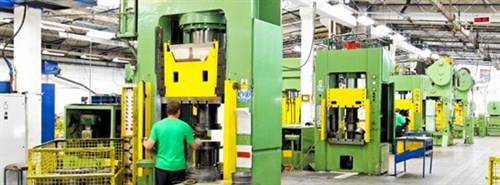When it comes to providing the best possible customer experience, machine manufacturers can act on many possible opportunities for collaborative innovation and proactive commerce that can benefit themselves and their customers. Today, we consider a sample scenario that enables manufacturers to generate a solid return from their investment in the internet of things (IoT) and that maintains a high level of lifecycle machine productivity throughout their entire lifecycle.
Avoiding the late-lifecycle productivity loss of machinery
Going beyond the maintenance scenario in our last blog post, many other possibilities are open to machine customers and manufacturers when they take advantage of the IoT, mobility, and modern ERP. Most customers will expect to keep their machines running as productively as they can, and eventually the benefits of operating a machine decline when its design becomes outmoded or the cost and time consumed by repairs is no longer commensurate to the return. The machine is replaced and the cycle starts over.
However, the machine manufacturer can deliver a greater customer experience throughout the lifecycle of the machine without a deterioration of machine productivity and ROI, by introducing improvements as opportunities arise. The manufacturer can create innovations on its own initiative, in response to customer requests, or in collaboration with the customer. This can also become a way to generate a greater return from an IoT investment. Customers can take advantage of continuous innovation as a service that continues to improve as they work with the equipment. Eventually, the machine will still need to be replaced, but it will be another step in the progress customer and manufacturer share, not a disruptive experience.
Machine maintenance leads to timely component replacements
Imagine, for example, that a machine has a cooling unit, connected to the IoT through sensors in its various components. As we saw in the previous blog post, submitting the machine data to maintenance standards can result in predictive maintenance that takes action before any performance degradation or outage can occur. An analysis of data from all of the customer’s machines shows that the cooling units are likely to experience certain issues after having been in use for a definite period of time. The manufacturer’s ERP system, where parts orders are handled, alerts the customer’s sales rep that it would be better to replace the cooling units.
Instead of dealing with every cooling unit in every machine individually, the machine manufacturer can have a conversation with the customer about replacing the cooling units everywhere, which might be more economical and more effective in ensuring that none of the units will fail. The ERP system produces the numbers to substantiate an improved ROI resulting from the replacements, and feeds information into the CRM system, where the rep can prepare a detailed customer proposal that includes the ROI projection. Proposal terms, including a suggested schedule and invoicing mode, as well as ROI information are accessible to customer stakeholders through the machine app. If the customer uses the machine under a SaaS agreement, the proposal could be in form of a relatively simple amendment to the existing contract.
The machine manufacturer designs equipment improvements
The IoT sensor data from the machine’s cooling unit also becomes available to the PLM system in the engineering department, where engineers and researchers analyze it as they review innovation opportunities and plan product enhancements. The engineering team determines that they are within close reach of designing an improved cooling unit that would last longer and use significantly less power. The new version of the cooling unit would fit into the customer’s machines and could easily be adapted for other customers. Engineers and the sales department define the business benefits and ROI scenarios for customers who have purchased their equipment as well as those who operate it within a service contract. Equipped with that information, an account manager can create a specific offer and discuss it with the customer’s decision-makers.

The customer invites innovative collaboration
Alternatively, consider a customer who has already been reviewing IoT data to closely track the cooling units’ power consumption, and who has verified that it does not follow the company’s standards for power management and sustainability. The director responsible for manufacturing or the shop floor manager challenge their machine manufacturer to improve the design of the cooling units. In doing so, they share their targets for power consumption and make themselves available to the machine manufacturer’s engineering group to discuss and plan the enhancement they are looking for. Collaboratively, customer and manufacturer establish the new cooling unit specifications and evaluate the likely resulting ROI. At the proper juncture, this conversation, too, leads to a well-substantiated proposal the manufacturer prepares for the customer.
Transitioning to innovation as a service provided by the machine manufacturer
As was the case with the parts replacements, in either scenario customers can access the proposal and supporting ROI detail in the machine app. From there, they can approve the innovation effort for the cooling unit along with its cost and schedule. The processes facilitated by the ERP system initiate any billing or contract updates and get the design and production of the new cooling units rolling. The details of the process are saved for reference to the machine’s master data and calendar.
If you are a machine manufacturer, you can by and by transition your installations to new, IoT-enabled service models at appropriate junctures in the customer relationships. That way, you can steadily improve your service and innovation delivery without exposing your other revenue streams at risk.
If lifecycle machine productivity and ROI from the IoT are of interest to you and your business, let’s find time to talk: Get in touch with an Industry expert




